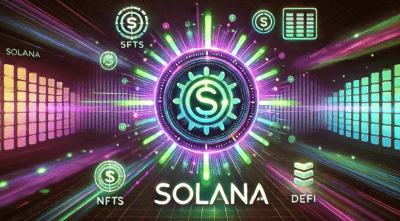Solana DeFi and NFTs in 2025: What’s Next?
The Evolution of Solana: A Brief Overview
Since its inception in 2020, Solana has rapidly evolved into a prominent blockchain network known for its exceptional speed and scalability. Developed by Anatoly Yakovenko, Solana introduced a novel consensus mechanism called Proof of History (PoH), which significantly enhances transaction throughput and efficiency. This mechanism allows Solana to process thousands of transactions per second, positioning it as a formidable competitor in the decentralized finance (DeFi) and non-fungible token (NFT) landscapes.
One of the key milestones in Solana’s journey is its ability to facilitate cheap and fast transactions without sacrificing decentralization. The platform has established itself as a leading choice for developers seeking to build decentralized applications (dApps), particularly in the crypto gaming sector. As a result of its robust framework, a myriad of projects have flourished within the Solana ecosystem, ranging from innovative DeFi protocols to vibrant NFT marketplaces.
The growth of the Solana community has also played a crucial role in its evolution. As the network attracted more users and developers, a culture of collaboration and innovation emerged, resulting in significant projects such as Serum, Raydium, and Solana-based NFT platforms. These projects not only leverage Solana’s unique technological capabilities but also contribute to the broader acceptance of the network, especially among artists and creators seeking to mint and trade Solana NFTs.
Moreover, the increasing interest from investors and institutions in Solana dApps has further stimulated the ecosystem’s growth. With substantial funding and partnerships, Solana is poised to enhance its capabilities and expand its reach within the crypto space. As we look toward 2025, the foundation laid by these milestones indicates a promising future for Solana in the realms of DeFi, NFTs, and beyond.
The Future of DeFi on Solana
The DeFi landscape on Solana is poised for transformative growth leading into 2025. With the rapid evolution of decentralized finance, the Solana platform is at the forefront of innovation, offering a unique combination of speed and scalability. As new financial instruments emerge, we can anticipate the development of sophisticated liquidity solutions tailored specifically for Solana’s infrastructure. These innovations will likely facilitate seamless trading and lending experiences, as well as enhance the overall liquidity within the ecosystem.
Additionally, the evolution of lending protocols on Solana will be significant in the coming years. We can expect to see more decentralized lending platforms that leverage smart contracts to provide efficient borrowing and lending options. These protocols will not only appeal to traditional investors looking for yield but also attract a broader audience interested in crypto gaming Solana and the myriad opportunities it presents.
Interoperability will play a crucial role in the future of DeFi on Solana. Partnerships and cross-chain integrations with other blockchains will enable users to access broader functionalities and innovative financial products. This interconnectivity will empower users to navigate seamlessly between different DeFi ecosystems, thus expanding the use cases of Solana DeFi applications.
The emergence of regulatory frameworks will also shape the evolution of the DeFi sector on Solana. As governments and institutions begin to develop and enforce regulations, the resulting compliance requirements may force projects to adapt their methodologies. Consequently, this could open up new avenues for creating secure and compliant financial instruments on the Solana network.
Moreover, decentralized autonomous organizations (DAOs) are expected to further influence the DeFi ecosystem on Solana. These entities, governed by smart contracts and community consensus, will play a pivotal role in decision-making processes for funding and project development in the DeFi space, driving community engagement and fostering innovation.
In conclusion, the next few years for Solana DeFi promise exciting developments in multiple dimensions, encompassing new financial instruments, enhanced interoperability, evolving regulatory requirements, and the influence of community-driven organizations.
NFT Market Growth and Trends on Solana
The non-fungible token (NFT) market has experienced remarkable growth, particularly within the Solana ecosystem. As we look towards 2025, the trajectory of NFT development on Solana appears promising, spurred by innovative use cases across various sectors, including gaming, art, and real-world assets. One of the most notable trends is the integration of NFTs into the gaming space. Crypto gaming on Solana is gaining traction, allowing players to own in-game assets securely as NFTs, thus revolutionizing the gaming experience. This integration enhances engagement as players can trade their assets on a vibrant NFT marketplace Solana offers, facilitating seamless transactions.
Moreover, the appeal of fractional ownership is emerging as a groundbreaking trend in the NFT space. This approach enables multiple investors to own a share of a high-value NFT, making it more accessible to a broader audience. Platforms on Solana are likely to continue developing mechanisms that support fractional ownership, potentially increasing liquidity in the NFT market and encouraging more users to participate in this growing trend.
Decentralized marketplaces are also on the rise, shifting how NFTs are bought, sold, and traded. These platforms allow creators to interact directly with buyers, eliminating intermediaries and reducing transaction costs associated with NFT transfers. The efficiency and cost-effectiveness of Solana’s blockchain technology—characterized by its speed and low transaction fees—have already made it an attractive platform for both creators and collectors, contributing to increasing transaction volumes and user engagement. As these decentralized dApps mature, we can anticipate an even more democratized approach to digital asset management and ownership.
With these growth trends and an increasing array of applications, the future of Solana NFTs looks bright. These developments will likely attract more creators, traders, and investors, thereby reinforcing Solana’s position as a leading platform in the rapidly evolving NFT landscape.
Challenges and Opportunities for Solana in the Coming Years
As Solana strives to solidify its position in the decentralized finance (DeFi) and non-fungible tokens (NFTs) landscape, it faces a series of challenges that could impact its growth trajectory. Foremost among these challenges is the intense competition from rival blockchain platforms. Other ecosystems are increasingly adopting innovative protocols which can offer similar or enhanced functionalities, potentially attracting developers and users away from Solana. This competition may lead to a significant decrease in traffic to Solana-based decentralized applications (dApps), making it imperative for Solana to distinguish itself prominently in the market.
Moreover, security remains an ongoing concern. Past incidents have highlighted vulnerabilities that could undermine investor confidence and deter new users from engaging with Solana’s DeFi or NFT marketplace. As the platform scales, ensuring robust security protocols will be crucial to protecting assets on Solana, particularly given the rising prominence of crypto gaming on this blockchain. Continuous investment in security infrastructure and proactive measures to address potential risks will be essential for fostering trust within the community.
Network congestion is another challenge that Solana must navigate. While the platform is known for its high throughput and transaction speeds, spikes in demand can lead to network delays, which may frustrate users and developers alike. Addressing these scalability issues by optimizing existing protocols or developing new solutions will be vital to maintaining a smooth user experience and supporting the expansion of Solana’s dApps.
Despite these challenges, there are numerous opportunities for Solana to capitalize on as it moves into 2025. Strategic partnerships with established entities in finance and technology could enhance Solana’s infrastructure and drive user adoption. Moreover, ongoing technological advancements have the potential to provide innovative solutions tailored to the needs of both developers and users. By focusing on usability and accessibility, Solana can attract a broader audience to its DeFi platforms and NFT offerings.
Ultimately, with keen attention to its challenges and a strategic focus on potential opportunities, Solana has the groundwork to thrive in an evolving blockchain landscape.





Post Comment